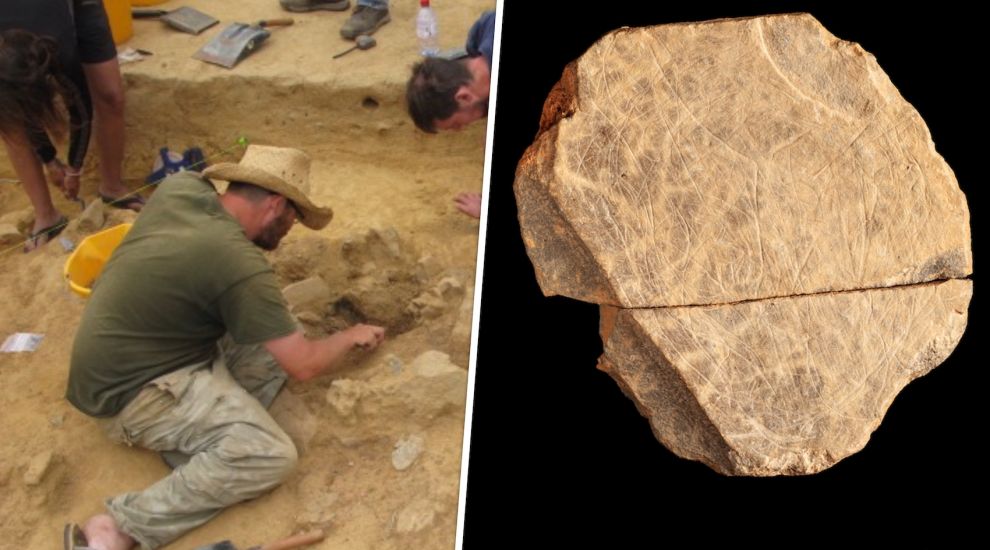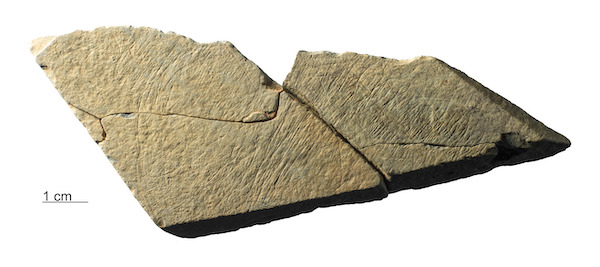


Archaeologists have confirmed that artistic designs found on stone plaquettes in St. Saviour are older than cave art, making them the earliest example of art in the British Isles.
The stones were found at Les Varines between 2014 and 2018 and are believed to be over 15,000 years old.
They were found as part of the Ice Age Island project, which was funded by Jersey Heritage and other organisations.
Launched in 2010, it saw team of experts from five British institutions undertake Palaeolithic research in the island.
Video: The stone plaquettes were found at Les Varines. (Jersey Heritage)
Located above St. Helier at the head of a dry valley dropping towards the sea, Les Varines is believed to have been occupied by Magdalenians, an early hunter gatherer culture dating between 23,000 and 14,000 years ago, immediately after the last glacial period.
The Magdalenian era saw a flourishing of early art - from cave art and the decoration of tools and weapons to the engraving of stones and bones.
Examples of etched Magdalenian plaquettes have previously been discovered at sites in France, Spain and Portugal.
Although Magdalenian settlements are known to have existed as far north-west as Britain, no examples of artistic expression of such an early date had been discovered in the British Isles until the plaquettes were uncovered at Les Varines.
Pictured: Les Varines is believed to have been occupied by Magdalenians, an early hunter gatherer culture dating between 23,000 and 14,000 years ago.
Between 2014 and 2018, ten fragments of stone plaquettes extensively engraved with abstract designs were uncovered at Les Varines, in an area believed to have been used as a hearth.
Three of the fragments were found around granite slabs which may have served as paving, highlighting that the plaquettes were engraved in a domestic context.
“The plaquettes were tricky to pick apart from the natural geology at the site - every stone needed turning,” Dr Ed Blinkhorn, Senior Geoarchaeologist at University College London and director of excavations at the site, said.
“Their discovery amongst hearths, pits, paving, specialist tools, and thousands of flints shows that creating art was an important part of the Magdalenian pioneer toolkit, as much at camp as within caves."
Pictured: Between 2014 and 2018, ten fragments of stone plaquettes extensively engraved with abstract designs were uncovered at Les Varines. (Ice Age Island)
“The engraved stones are firmly domestic art - this may have been important as people moved back into northern Europe towards the end of the last Ice Age,” Dr Chantal Conneller, Senior Lecturer at Newcastle University, added.
“The people at Les Varines are likely to have been pioneer colonisers of the region and creating engraved objects at new settlements may have been a way of creating symbolic relationships with new places.”
A team of archaeologists from Newcastle University, the Natural History Museum and University of York analysed the prehistoric markings and believe they date from the late ice age – some 15,000 years ago.
The engraved fragments represent the first evidence of engraved stone plaquettes found in the British Isles and Ireland, seemingly predating the cave art and engraved bone at Creswell Crags, Derbyshire.
“These engraved stone fragments provide exciting and rare evidence of artistic expression at what was the farthest edge of the Magdalenian world.” Dr Conneller said.

Pictured: The geometric designs are made up of a combination of straight lines more or less parallel to each other and longer, curved incisions. (Sarah Duffy/Ice Age Island)
The research and excavation team, which also included experts from the universities of St. Andrew’s, Strathclyde, Liverpool, Wales, as well as UCL Institute of Archaeology and the British Museum also analysed the stones for traces of how the markings were made.
The analysis revealed that the plaquettes are engraved with groups of fine lines, thought to have been purposefully made using stone tools. The geometric designs are made up of a combination of straight lines more or less parallel to each other and longer, curved incisions.
The research team say that the two types of marks are likely to have been produced using the same tools, possibly by the same engraver and in short succession, giving new insight into the processes used to create the ancient designs.
Pictured: The stones are the earliest evidence of artistic expression in the British Isles. (Ice Age Island)
The designs were only briefly viewed by their makers. Engraving soft stone creates a powder within the incisions that makes them visible. This swiftly disperses, meaning that the engravings are only clear at the moment of their making. In this context, the act or moment of engraving, was more meaningful than the object itself.
“Microscopic analysis indicates that many of the lines, including the curved, concentric designs, appear to have been made through layered or repeated incisions, suggesting that it is unlikely that they resulted from the stones being used for a functional purpose,” Dr Silvia Bello, Researcher at the Natural History Museum, London, explained.
“The majority of the designs are purely abstract, but others could depict basic forms such as animals, landscapes or people. This strongly suggests that the plaquettes at Les Varines were engraved for purposeful artistic decoration.”
Jersey Heritage hopes the stones will be returned to Jersey before the end of the year, when they will then go on display.
Comments
Comments on this story express the views of the commentator only, not Bailiwick Publishing. We are unable to guarantee the accuracy of any of those comments.